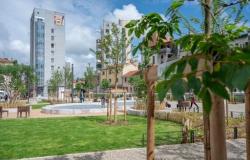
Since 2017, the Bordeaux municipality has been installing memory paving stones in the streets, to maintain the memory of resistance fighters and deportees from the Second World War.
Le Figaro Bordeaux
There were crowds in Rue des Augustins this Monday afternoon. A few hours later, the reason for their presence will however become discreet. On the ground, in front of number 19, two paving stones covered with inscriptions have just been installed. They bear the names of a father and his daughter, two Girondin resistance fighters. Jean-Bernard Bonnafon was shot and killed in 1942. Germaine Bonnafon was imprisoned in France and then sent to concentration camps. These paving stones are there to remind us that 19 rue des Augustins was their address, to perpetuate the memory of their fight against the occupation.
The “Stolpersteine”, literally “stumbling stones” in German, were created by Berlin artist Gunter Demnig. He began installing them in public spaces in the 1990s. A marginal initiative which has become popular: today, nearly 100,000 Stolpersteine are embedded in the ground of German and European municipalities. Bordeaux, in 2017, was the first large French city to engage in this project in memory of the Jewish victims and resistance fighters of the Second World War, by installing these concrete paving stones in front of houses covered with a brass plate with the names and life histories of the former occupants.
“These paving stones pay homage to the victims of Nazi barbarity in front of the last homes they had”explains Olivier Escots, deputy mayor responsible for the fight against all discrimination, recalling that Jean-Bernard and Germaine Bonnafon are part of “those who stood up when our country was plunged into darkness”creating “the conditions for hope to always be present”. A former member of the national navy during the First World War, Jean-Bernard Bonnafon ran a clandestine printing press in the back of his store. Arrested on August 25, 1942, he was shot less than a month later at the Souge camp, on the outskirts of Bordeaux.
Jean Cittone / Le Figaro
A death camp survivor
Before his arrest, Jean-Bernard managed to convince his daughter to flee to Paris. Engaged with her father since 1940 and a member of the network of communist deputy Charles Tillon, Germaine Bonnafon continued to work for the Resistance in Paris, before also being arrested in April 1943. She then passed through six French prisons and two concentration camps. , in Ravensbrück, in Germany, then in Zwodau-Falkenau, in present-day Czechia, explains anthropologist Carole Lemée, specialist in the Shoah in Gironde.
“This is the very first time that the city of Bordeaux has honored local resistance fighters”, rejoices the researcher during the laying of these two new paving stones of memory, the previous recipients of these tributes being all foreigners or stateless people. Survivor of the death camps and return to Gironde after the end of the war, Germaine Bonnafon devoted a large part of the rest of her life to the duty of memory, notably within the national federation of deportees and internees resistant. and patriots. She died on December 5, 2016 in Pessac (Gironde), at the age of 94.
The cobblestones of memory dedicated to Jean-Bernard and Germaine Bonnafon are the 20e and 21e to be installed in Bordeaux. A journey of memory begins to take shape on the sidewalks of the Port de la Lune. On the human rights square, three paving stones have since 2017 borne the names of Austrian resistance fighters Alfred Loner, Alfred G. Ochshorn and Fritz Weiss, detained at Fort du Hâ and deported from Bordeaux in 1943. At 199 rue Achard, a Stolperstein pays tribute to Doctor Sabatino Schinazi, nicknamed “the doctor of the poor”, deported to Auschwitz then to Dachau where he died. 5 rue Louis Mie, two paving stones pay tribute to Berthe and André Murrate, arrested during the last roundup that took place in Bordeaux, on January 10, 1944.
Jean Cittone / Le Figaro





